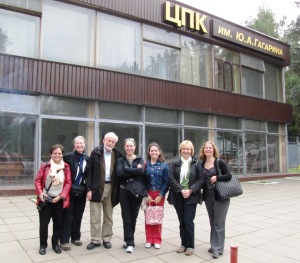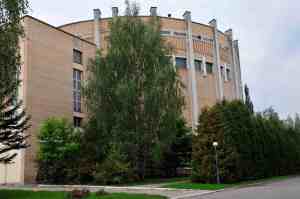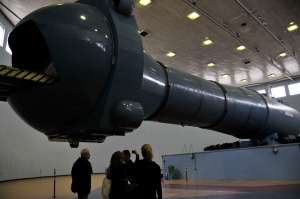On September 14, a group of us Fulbrighters visited the Yuri Gagarin Cosmonaut Training Center. For those of you not old enough to remember, Gagarin was the first human in outer space and the first to orbit the earth (see picture of his statue on the grounds). He died not that long afterward, in 1968, when MIG fighter plane, in which he was re-training as a pilot, crashed in bad weather. He is buried along with many other famous Soviet heroes in the Kremlin wall.
In any case, what had previously been known as “Star City” was renamed in his honor, so it is now also known as the Yuri Gagarin Cosmonaut Training Center. To get there, you have to take a metro train to the end of the line (the last few stops are above ground). Then, you need to take a “marshrutka,” which is really a privately run bus, although sometimes marshrutkas are no bigger than vans, a good long way (at least ½ hour). Along the way, we were reminded that there must be more fences in Russia than anywhere else on earth! Everything has a fence around it!
Eventually, the marshrutka drove through a beautiful forest and, of course, we arrived at a building, behind which was a fence, a gate and a soldier.
 Here we are, all gathered in front of that building for a photo opp.
Here we are, all gathered in front of that building for a photo opp.
After about 10 minutes, our guide arrived. Alexander had worked at star city as an engineer, helping to train cosmonauts in the centrifuge (more about that later) and other specialized equipment (such as the pool used to simulate weightlessness), and undergoing much of cosmonaut training himself. He spoke English quite adequately. He led us first around the welcome building, and then back and through it. He explained to us that Russian cosmonauts achieved every “first” and “record” in space except landing on the moon. In addition to the first man in orbit, Russian cosmonauts have spent the most time in space and done the longest extravehicular maneuvers in space.
Our first stop was the building housing the giant centrifuge. 
This centrifuge was built in collaboration with Finland and is the largest centrifuge in the world. The capsule in which a cosmonaut is placed for training can go in all directions, since it has something like a universal joint. So in addition to generating “g” force, the centrifuge can generate them in any direction relative to the person undergoing training.
After the centrifuge, we saw the building housing the weightlessness pool. There is a big platform with a capsule, and the capsule can go underwater, or the man in the space suit can go underwater without the capsule. With the latter, scuba divers go in with the spacesuit man, and that is one of the jobs our tour guide had performed, before he retired.
Finally, we saw the building housing both a full size model of the Mir space station, as well as a landing capsule.
Of course, we all know what happens at the end. You go to the souvenir shop! (But I didn’t buy anything.)
Then back on the marshrutka, then the metro, to get back into Moscow. Having gotten on the first subway train at about 11:30 and then returned to central Moscow about 6:30, we were starving. Lunch had long past without us!
Overall impression: The training center is situated in a beautiful forest, not unlike many other important Russian scientific institutes. But it has clearly been on hard times for a while. Although we were told that it is still being used, most of the buildings have not been updated (except perhaps for paint) in a couple of decades, from the looks of them. And hardly any people were visible, although there were lots of hallways with keypad locks that seem to house offices, and perhaps labs. But busy? Definitely not! Nevertheless, the Russian space program is clearly proud of its past accomplishments and that it is still operating a space station that has hosted astronauts from many other countries.


Hi there,
Thank you for sharing this! I’m going to be in Moscow late March and interested in visiting the site. Did you arrange your own visit through their official website and then make your own way from Moscow to the site? How much was the fee? Thanks so much in advance for the help.
We took public transportation (metro and bus); it took a while but it is not difficult. I was not the one in our small group (about 6) who arranged the visit, so I don’t remember about tickets or tour arrangements, other than we did have a guide. But you probably have to be prepared for a guide who speaks Russian, not English. (I don’t remember what language ours spoke.) Sorry I can’t be of more help. It is worthwhile.